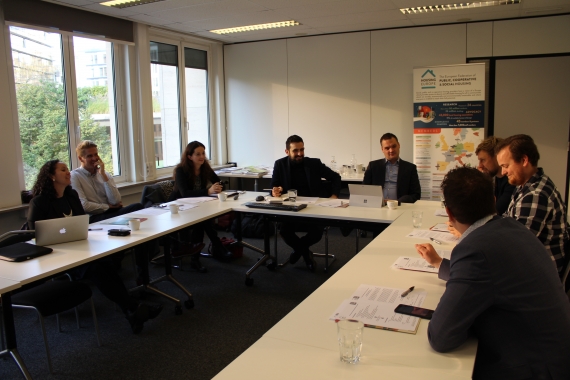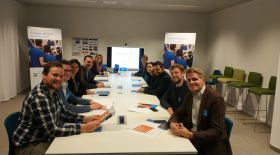Working together to strengthen the voice of the public, cooperative and social housing providers
Housing Europe Communications Network 2nd meeting key points
Brussels, 14 November 2018
The second meeting of the Housing Europe Communications Network took place in Brussels, on November 5th 2018 and it has been an opportunity to introduce everyone to the Brussels scene, the role of Housing Europe within it and to discuss how we can co-produce the Housing Europe campaign for the 2019 European Elections. Furthermore, this was an occasion to brainstorm concerning the best ways of collaboration on a regular basis unlocking the full potential of our network. Sharing the milestones of 2019, an eventful year, given the European Elections, the second International Social Housing Festival and the next edition of ‘The State of Housing in the EU’ will indeed be a good way to start.
The meeting kicked off with a tour de table to get to know each other, as most faces have changed since the first meeting three years ago. After briefly presenting their organisations and the way the EU agenda is incorporated in their work, most of the participants highlighted that the key is to make the link with the national level, explaining clearly the implications that EU developments may have for tenants. This is also part of the potential of this group, namely to help our members’ heads of communications in doing so.
Then, the group discussed the campaign Housing Europe is about to launch in light of the European Elections. Michalis presented the draft Manifesto as well as the plan for a video to introduce the core messages to be ready for mid-January 2019. The group backed the idea for a more collaborative campaign this time, compared to 2014 although it was clear that members of members and in particular smaller companies do not really care about the big issues, rather distant issues of the EU agenda. The support from members could unfold as follows:
- multiplication of the messages on social media, especially in the respective languages in order to maximize the impact
- some members expressed the interest to use their Chairs as campaign ambassadors. This would mean either short video messages or quotes by the Housing Europe members’ leaders. Again, preferably in their own language and aiming to contextualize the big picture into the national/local reality
- Michalis can send members the Google translated version of the video subtitles and the network members will finetune it, so that the campaign video is accessible in as many languages as possible
- HSB suggested that they will make the link between the EU dimension and the national angle in one of their magazine issues – they have to have the content asap.
Next point on the agenda was related to the national priorities.
HSB and Rigsbyggen stressed that the political week in summertime in Sweden- similar to Denmark- is the annual milestone for them. Coming up with financial solutions for young adults facing increasing difficulties to access affordable housing is higher and higher on the agenda. Rene from HSB, in particular, underlines that providing adequate solutions for young adults will be an issue for many years to come. Sustainability, both socially and economically, is a pillar of their work, while both of them would like to show closer engagement within their networks, both at national and at EU level. Cattis from Rigsbyggen said that indeed the EU elections are not a big issue nationally.
Katharina from GdW said that the national priority is to deliver new solutions that can boost provision of affordable housing, as there is a shortage in the country. More details along with information about the organisation’s actions ahead of the elections like the dedicated website ‘GdWzurWahl’ can be found in her presentation below.
Robin from Aedes put emphasis on the battle they taking place at the moment, since Aedes and its members are asked to do more under more difficult and limiting conditions. According to Robin, Aedes has a tricky balance to strike between the increasing fiscal burden, also because of the new tax regulation, and the commitment to deliver more homes. When it comes to the EU elections, things will move more around personal contacts.
For Kris from BL the national elections in Denmark are the most important milestone. BL has to showcase to politicians the added value of the sector and therefore they are planning an interesting campaign with tenants at the centre as protagonists. Kris underlined that a lot of local campaigning around housing is going on in the country at the moment.
Charlelie said that SLRB has just recently put together a young comms team. The organisation, also due to Yves Lemmens’ long standing engagement within Housing Europe pushes more and more for communication around European issues. He pointed out that they are not planning any actions around the elections, this is the case for every election, even the local ones. In general, they aim at avoiding hard communications, preferring a softer approach.
Klaus highlighted on behalf of GBV that in Austria at the moment, the gap between the rest of the regions and Vienna is central in the national debate. Local and regional regulations raise a challenge for federations like GBV. The Austrian federation invests resources in making the case that limited profit providers renovate much more than the private sector. This distinction is a crucial challenge, as they have to convince the government, while attracting the media attention, too.
Cross-cutting themes
Three main cross-cutting themes came out from the exchange around the national priorities that may provide with hooks for collaboration within the comms network in the future:
- Providing decent, affordable homes for young adults, so that they can have access to independent living. This is not the case in many countries, even for young people in employment.
- The implications of short-term rentals and of the overall digital sharing economy on the affordable housing stock is a major issue of concern across Europe, in particular in cities that attract many tourists.
- Striking a balance between sustainability and affordability is challenging in many countries. Public, cooperative and social housing providers invest in energy efficient refurbishment offering better living conditions to their tenants but they are often confronted with complaints concerning the cost that may be integrated in rent rise. This is a sensitive issue in Sweden, for instance. In Germany, they calculate that 11% of renovation costs are reflected on the rent. How do housing associations deal with this?
Future of the Network
After the coffee break, the discussion shifted towards the future of the network. The group unanimously agreed that indeed this is a useful initiative/resource that all organisations need. Based on that, the network will stay in touch making use of concrete milestones in 2019 to facilitate the cooperation.
Apart from the collaboration for the EU election campaign mentioned above, the Communications Network will play a key role when it comes to the launch of ‘The State of Housing in the EU’ 2019, due in autumn 2019, report. The flagship publication of the Housing Europe Observatory offers a great opportunity for visibility and for making the link between the overall message and findings around housing in Europe and the respective national realities. The Network can maximize the national press coverage and make sure that the report messages are tailor-made to the national realities and audiences. Michalis will be getting in touch on this just before summer 2019.
At the same time, the Network can be the messenger both for the 3rd edition of the European Responsible Housing Awards and the for the 2nd International Social Housing Festival, 4-8 June 2019 in Lyon. The aim is to attract as many members of members as possible that will submit their projects to the competition and to make sure that Housing Europe members have a strong presence with their own events in Lyon.
As far as the way to work together is concerned, everyone agreed that to start with, the mailing list (everyone got a copy but also below) is the best option.
Exchange around challenges and best practices
The first part of the day concluded with an open debate around challenges and best practices from the network members’ working reality.
Klaus from GBV said that they work with agency when it comes to the newsletter, while the standard procedure is to discuss the content with the legal team and the managing director. Twitter seems to be a useful addition to the everyday working routine that also includes a lot of phone calls. On the other hand, the issue of pictures, both in terms of availability and quality, a point that the group unanimously agreed with as well as with the fact that time is usually an issue especially when dealing with journalists. With regards to press relations, Klaus highlighted that the press conferences are less and less effective in contrast to GdW in Germany, as Katharina said that the annual press conference is a key milestone and they now offer it also via livestream.
Katharina underlined the fact that they have a small team, lacking an in-house designer, as is the case for BL in Denmark, that would their life easier. GdW is making use of long-established personal contacts, in particular with specialised journalists and is now planning to relaunch its website. More and more, they are trying to involve their members and to this end Katharina mentioned different examples with competitions that helped them gather innovative projects and ideas from members.
SLRB has been for a few months on Instagram and this turns out to be a success according to Charlelie, especially thanks to the nice pictures that the organisation’s architects provide. Additionally, ‘Contour’ magazine is also a communication pillar, an excellent mapping exercises of their activities.
Kris from BL got everyone jealous mentioning that they have 2 in-house graphic designers and he highlighted that facebook and twitter indeed are effective means in the Danish scene. Kris also shared a recent initiative that proved to be a success, when BL opened its HQs for a cultural evening attracting more than 500 people in an excellent way to show the practical support the sector gets from the general public.
Rene shared that HSB recently hired a social media expert and they invest in their potential, particularly when it comes to short, native, videos. Social media and their report on housing issues are the most effective means in their work.
Finally, Cattis explained how Rigsbyggen uses social networks in different ways, namely Instagram more for business-oriented comms, Facebook for the general public and Twitter mainly for policy purposes.
European Parliament Visit
The meeting came to an end with a visit to the European Parliament, where the group was welcomed by the Spokesperson Unit. Two presentations were held, one dedicated to the EP campaign in light of the elections and another one showcasing the work of the newly established taskforce debunking disinformation and misinformation. In case there is interest for additional information, feel free to contact Anja Duchateau at anja.duchateau@europarl.europa.eu and Sol de la Guardia at sol.delaguardia@europarl.europa.eu
